The Best POS System for Restaurants: Recipe for Success
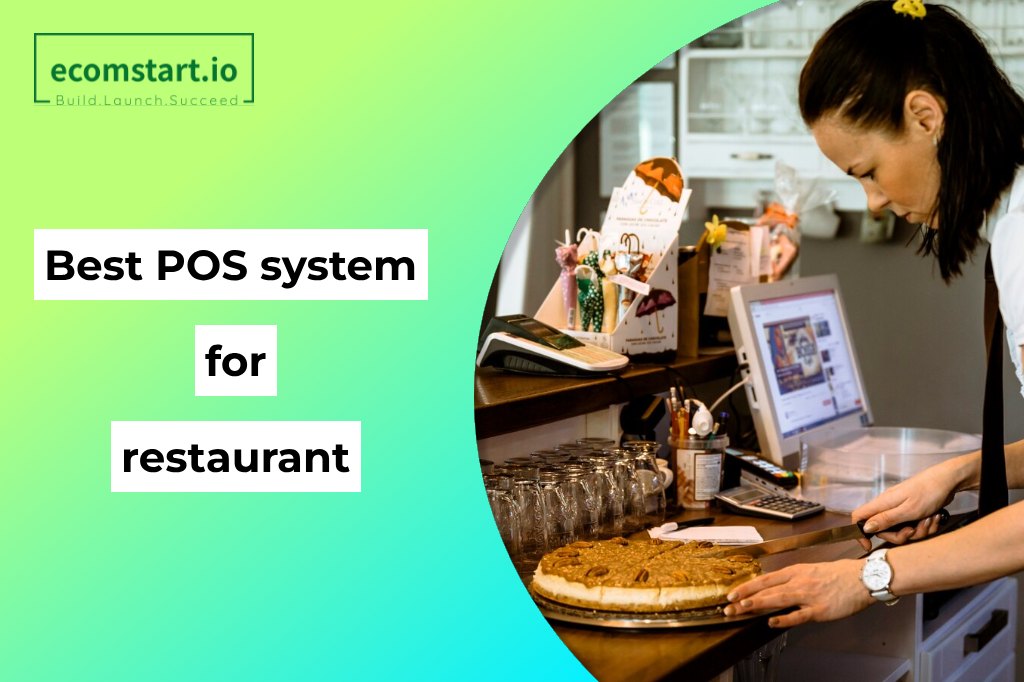
Every successful dish has its own unique recipe. Similarly, your restaurant’s recipe for success likely involves a powerful Point-of-Sale (POS) system. In today’s restaurant landscape, where customer experience and operational efficiency are key to success, the right POS system can make all the difference. To go deeply in the competitive food and beverage industry, choosing the best F&B POS system is very essential.
This guide delves into the key ingredients – essential features, integration possibilities, and cost considerations – to help you select the best POS system for restaurants and set it on the path to culinary triumph.
Are you ready? Let’s get it straight!
1. A comparative overview of the best POS system for restaurants
| Best for | Pricing | Transaction fees from | Key Features | |
| Shopify POS | Best for retail and small restaurants | $5/month – $89/month | Dependent on third-party payment processor | Recipe-based inventory tracking, order splitting for dine-in, kitchen printer integration |
| Toast | Best for contactless ordering | $0 – $69/month | 2.49% + $0.15 | POS built specifically for restaurants, payroll, online ordering, team and inventory management |
| Square POS | Best for single-location food businesses | $0 – $153/month | 2.6% + $0.10 | Payroll, loyalty programs, marketing & team management tools |
| Clover | Best for quick-service restaurants | $105 – $220/month | 2.3% + $0.10 | Versatile POS, invoicing, employee management |
| Lightspeed | Best for cafes | $69 – $399/month | 2.6% + $0.10 | Table management, online ordering, gift cards, loyalty programs |
| SpotOn | Best for full-service restaurants with 1 or multiple units | $0 – $135/month | 1.99% + $0.25 | Online ordering, labor management, reservations, loyalty programs |
2. What is the best POS system for restaurants
A POS (point of sale) system is a software application that manages and tracks sales transactions and related activities at a restaurant.
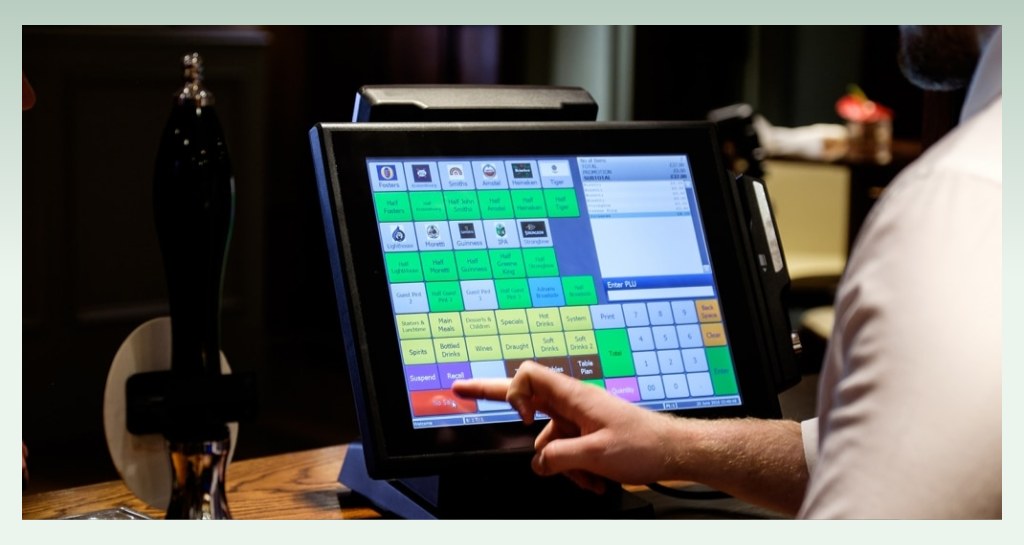
There are two main categories of restaurant POS systems:
- On-premise POS Systems: These systems are installed on a local server or computer at your restaurant. They offer greater control and customization but require upfront investment in hardware and software licenses.
- Cloud-based POS Systems: These systems are hosted on a remote server and accessed through the internet. They offer greater flexibility, scalability, and lower upfront costs, but you rely on internet connectivity for functionality.
POS systems are essential for restaurants of all sizes, from small cafes to large chains, to streamline operations, improve efficiency, and enhance customer satisfaction. It serves as the central hub for order processing, payment acceptance, inventory management, employee management, customer relationship management (CRM), and reporting.
To be more specific, the best POS system for restaurant typically includes these key features:
- Order Management: Ability to handle multiple orders simultaneously, track order status, and communicate effectively with the kitchen.
- Inventory Management: Real-time inventory tracking, purchase order generation, low stock alerts, and ingredient usage reporting.
- Labor Management: Employee scheduling, time tracking, payroll reporting, and labor cost analysis tools.
- Customer Relationship Management (CRM): Customer data collection, purchase history tracking, loyalty program management, and targeted marketing capabilities.
- Table Management: Real-time table status updates, waitlist management, reservation handling, and table turnover tracking.
- Menu Management: Easy menu editing, customization options, allergen information display, and menu item modifiers.
- Kitchen Display System (KDS): Real-time order display, order status updates, and kitchen communication tools.
- Reporting and Analytics: Comprehensive sales reports, inventory reports, labor reports, customer behavior reports, and customizable dashboards.
- Integrations: Integration with accounting software, payroll software, online ordering platforms, and delivery services.
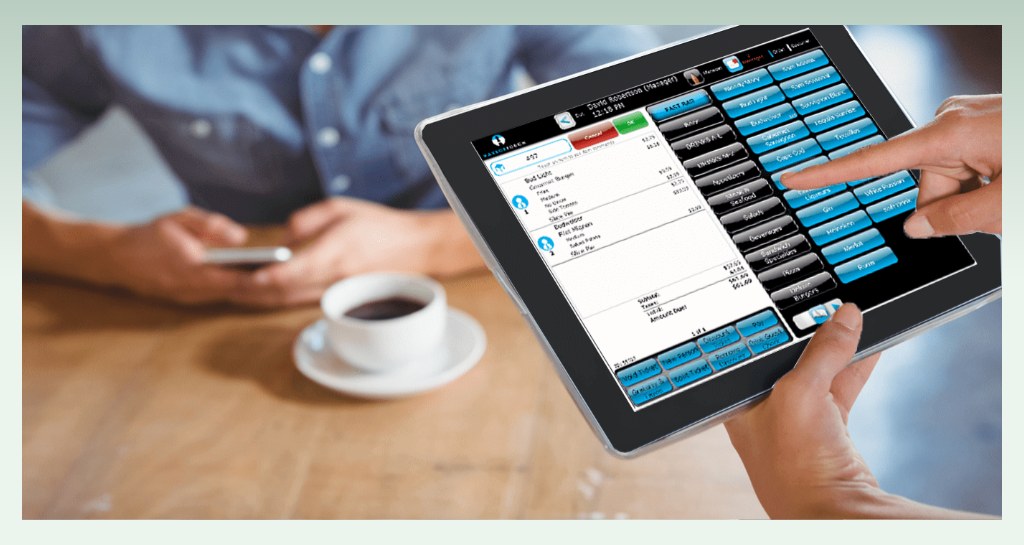
In today’s competitive restaurant industry, having a reliable and effective POS system is not just an option; it’s a necessity. Here are some compelling reasons why you need a POS system for your restaurant:
- Improved efficiency and accuracy: Streamline order taking, processing, and kitchen communication, reducing errors and improving order accuracy.
- Enhanced customer experience: Provide faster service, minimize wait times, and offer personalized experiences to customers.
- Better inventory management: Track inventory levels, optimize stock levels, and reduce waste, saving money and preventing stock-outs.
- Valuable data and insights: Gain insights into sales trends, customer behavior, and employee performance, enabling data-driven decision-making.
- Scalable growth: Adapt to growing demand, new locations, and additional staff with a scalable POS system.
- Competitive edge: Stay ahead of the competition by leveraging technology to enhance operations and customer experiences.
Choosing the right POS system is an investment in the success of your restaurant. By carefully evaluating your needs and considering the features and benefits of different systems, you can select a solution that empowers your business to thrive.
So now, armed with this knowledge, we’ll dive deeper into a detailed review of the 6 POS systems we mentioned above to help you find your best point of sale system for restaurant.
3. The best restaurant POS systems 2024: A comprehensive review
3.1. Shopify POS: Best for retail and small restaurants
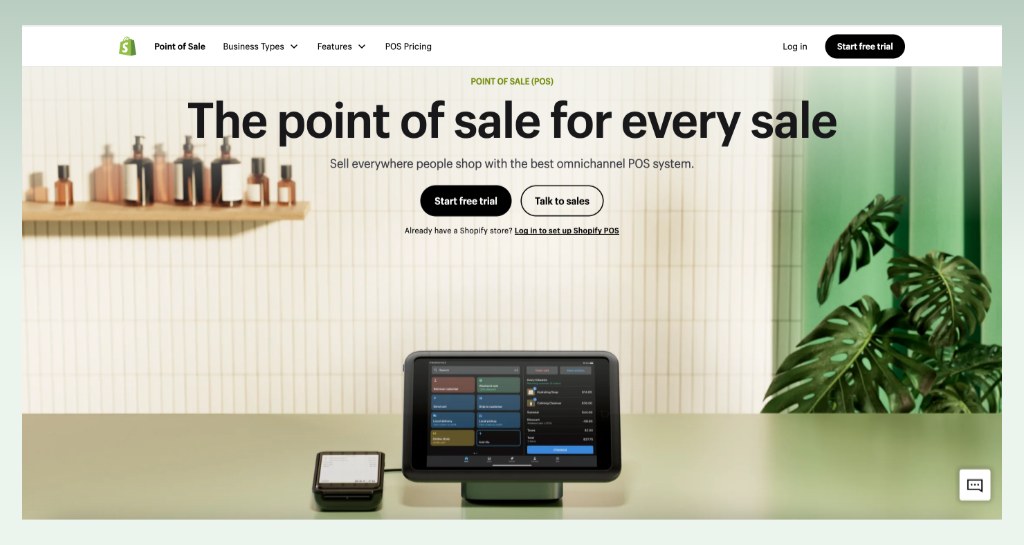
As one of the best POS systems for small businesses, Shopify POS has established itself as a popular choice for restaurant businesses, offering a user-friendly interface, comprehensive feature set, and seamless integration with Shopify’s eCommerce platform.
Although Shopify POS lacks some restaurant-specific features, such as built-in table management, a reservation system, and a dedicated KDS, it is still one of the best rated restaurant POS systems by providing specialized functions that benefit small restaurants.
Here are some ways this best POS system for small restaurant benefits restaurants with specialized features:
- Order Management: Manage order types, modifiers, split checks, and integrate with kitchen printers.
- Inventory Management: Track inventory by recipe, receive low stock alerts, and manage waste/purchases.
- Customer Engagement: Create customer profiles, offer loyalty programs and gift cards, and send digital receipts.
- App Integrations: Extend functionalities with apps for table management, KDS, and menu management (additional costs).
- Omnichannel Experience: Create an online store for ordering, offer QR code ordering at tables, and utilize mobile POS for on-the-go transactions.
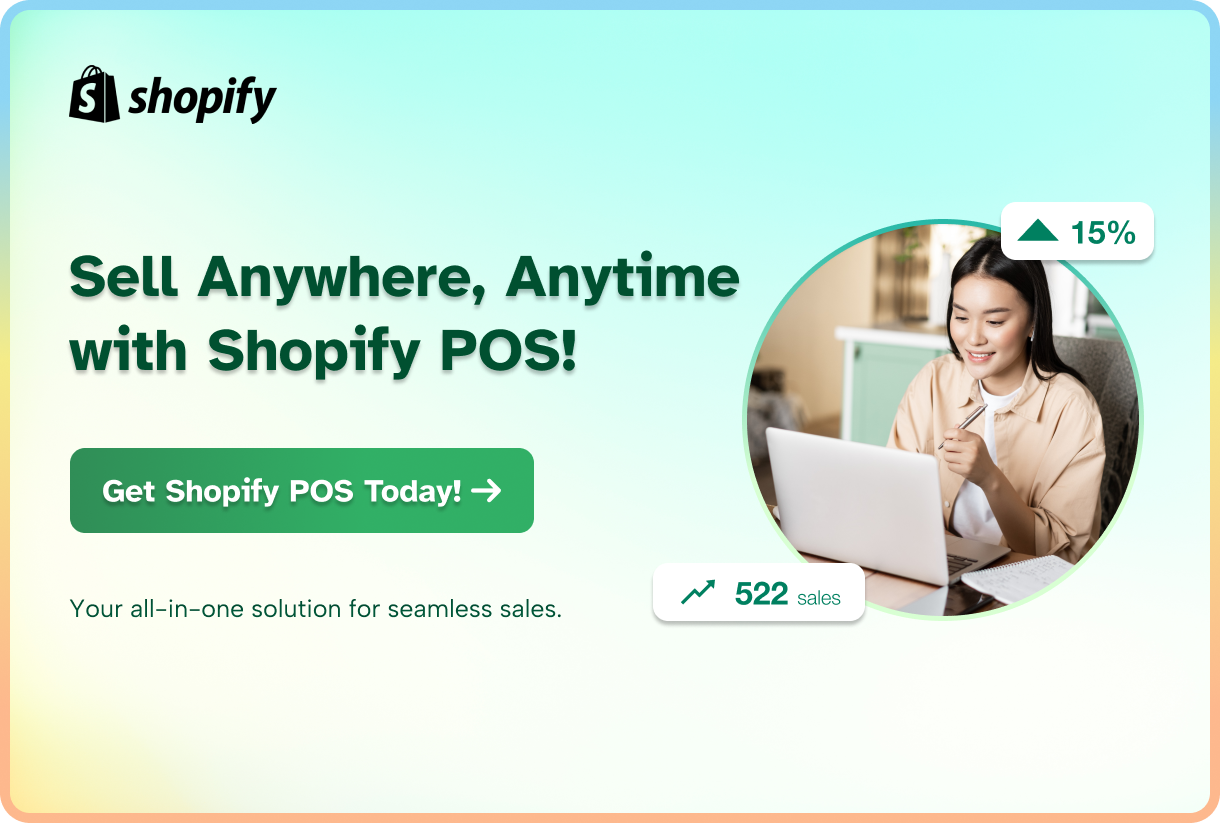
Shopify POS Lite (basic POS functionalities) is included with every Shopify pricing tier (except Starter). This means if you already have a Shopify plan, you won’t incur additional POS fees – a significant advantage for budget-conscious restaurants.
On the other hand, Shopify POS Pro is ideal for restaurants with a higher transaction volume or those requiring advanced features like faster checkout, staff permission controls, and inventory management tools. This plan costs $89/month per location (or $79/month if billed annually).
Here’s a breakdown of Shopify POS pricing:
| Shopify POS Lite | Shopify POS Pro | |||
| Price | From $39/month | $89/month/location | ||
| Transaction fees | 2.9% + $0.30 online payments 2.6% + $0.10 in person | 2.9% + $0.30 online payments 2.6% + $0.10 in person | 2.7% + $0.30 online payments 2.5% + $0.10 in person | 2.5% + $0.30 online payments 2.4% + $0.10 in person |
| Hardware packages | – Retail kit: $219 – Barcode scanners: $229 to $329 – Label printers: $299 to $499 – Receipt printers: $299 to $369 – Cash drawers: $139 to $159 – POS Go (with case): $429 | |||
🔍 If you’re exploring Shopify POS as a potential solution, our Shopify POS Reviews dives into everything you need to know about its detail features, pricing, and user experience.
3.2. Toast: Best for contactless ordering
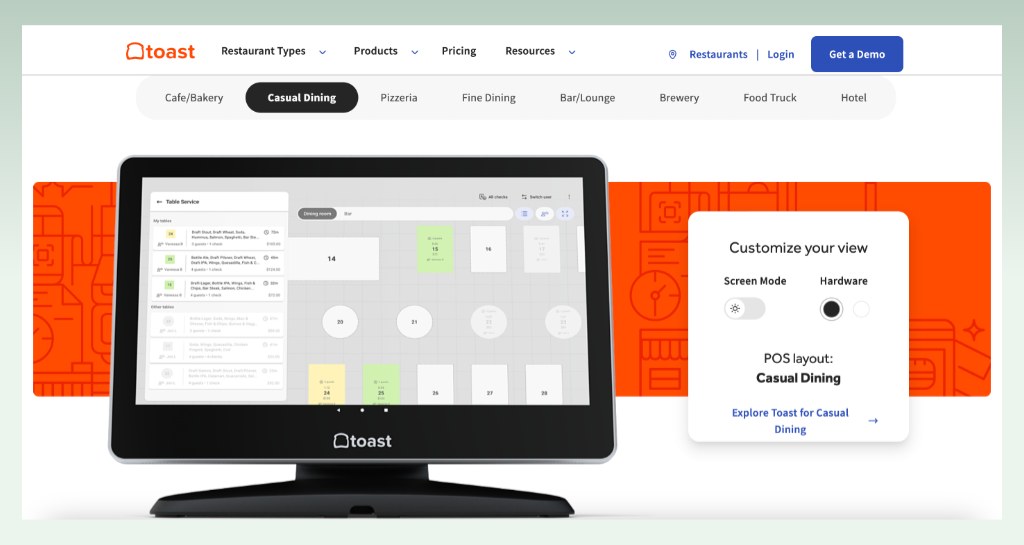
Toast POS has solidified its position as a leading point-of-sale (POS) system specifically designed for restaurants. Its feature-rich platform caters to businesses of all sizes, from single-location cafes to multi-unit fine-dining establishments.
However, it is not compatible with iOS devices, and customization flexibility might be limited for certain needs. Additionally, some plans may require long-term contracts.
Toast has a suite of features that address critical restaurant needs:
- Inventory Management: Real-time inventory tracking, low-stock alerts, and automatic reordering capabilities help optimize inventory control and minimize stockouts.
- Menu Management: Create and customize menus with ease, including options for online ordering.
- Table Management: Efficiently seat customers, manage waitlists, and optimize table utilization.
- Order Management: Streamline order processing for dine-in, takeout, and delivery channels.
- Kitchen Display System (KDS): Improve communication between front-of-house and back-of-house staff by displaying orders clearly.
- Digital Ordering: Enable contactless ordering through QR codes or online platforms, enhancing customer convenience and safety.
- Delivery Management: Manage online orders and integrate seamlessly with third-party delivery services like Uber Eats and DoorDash.
- Cost Management: Analyze labor and food costs to identify areas for optimization.
- Profit Margin Calculator: Track your restaurant’s margins and identify areas for improvement.
- Automated Tip Sharing: Simplify tip splitting among wait staff, saving time and effort.
Toast employs a tiered pricing structure:
| Starter Kit | Point of Sale | Build Your Own | |
| Price | Free | $69/month | Custom |
| Transaction fees | 2.99% + $0.15 | 3.5% + $0.15 | 3.5% + $0.15 |
| Hardware packages | Offers a full hardware suite for $799 but custom pricing is available on more expensive software tiers | ||
3.3. Square POS: Best for single-location food businesses
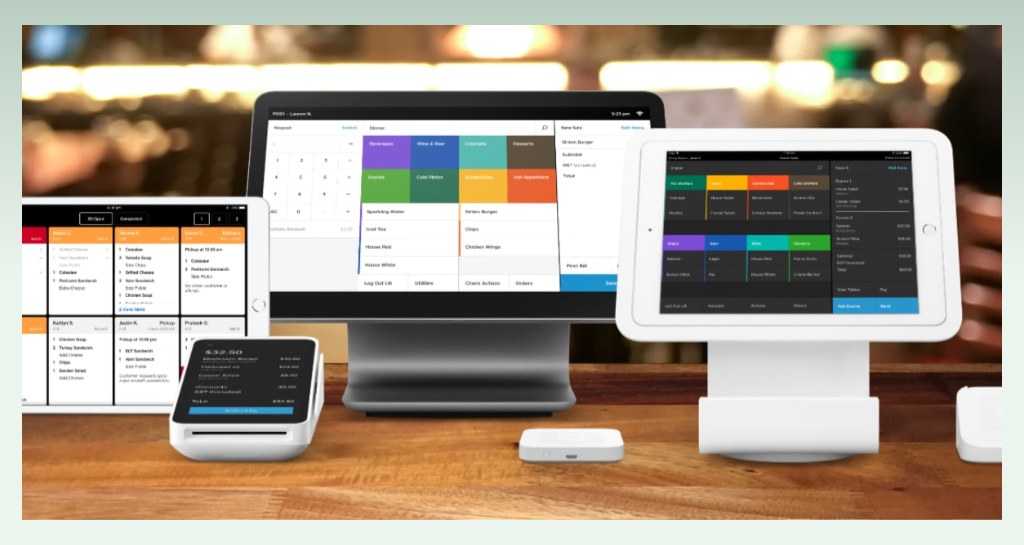
Square POS has carved a niche as a user-friendly and cost-effective point-of-sale (POS) system, particularly well-suited for restaurants, cafes, and food trucks. Its intuitive interface, flexible pricing structure, and robust feature set empower restaurants to streamline operations, enhance customer experiences, and gain valuable insights to drive growth.
The best POS system for restaurants goes beyond basic POS functionalities with features specifically designed for restaurants:
- Course Management: Manage multi-course meals and track order progress.
- Table Management: Efficiently seat customers, manage waitlists, and optimize table utilization (limited customization compared to some competitors).
- Inventory Management: Track food costs, prevent stockouts, and streamline ordering processes.
- Menu Management: Create customizable layouts, and group items, and manage menu changes effectively.
- Discounts and Promotions: Implement automatic discounts for specific items, categories, and daily specials (particularly useful for happy hours).
- Customer Recognition: Identify customers using QR codes or barcodes for loyalty programs or group discounts.
Square POS maintains a transparent pricing structure, allowing restaurants to choose the plan that aligns with their budget and needs:
| Free Plan | Restaurant Plus | Essentials Bundle | |
| Price | Free | $60/month | $153/month |
| Transaction fees | 2.6% + $0.10 for card-based transaction 3.5% + $0.15 for manual keyed-in sales 2.9% + $0.30 for eCommerce payments | ||
| Hardware packages | – Contactless reader: $49 – Portable terminal: $299 – Square terminal and stand: $799 | ||
When comparing Shopify POS vs Square POS, we can see that the processing fees of Square POS might be less cost-effective for high-volume restaurants. Square also lacks advanced features like ingredient tracking and cost management, which are important for larger chains.
3.4. Clover: Best for quick-service restaurants
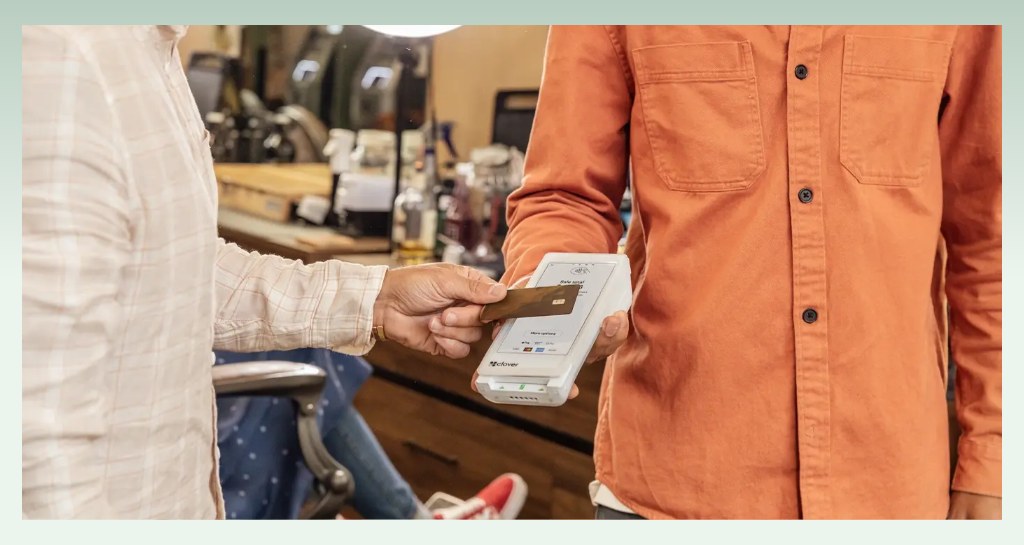
Clover POS is a powerful contender for restaurants seeking a comprehensive POS system with industry-specific features, scalability, and excellent customer support. While Clover offers solutions for various industries, it particularly shines for quick-service and full-service restaurants.
Clover POS shines for restaurants, offering a robust suite of features specifically designed to enhance customer experiences and boost sales:
- Order Management: Manage orders efficiently across various channels, including dine-in, takeout, and delivery.
- Kitchen Display System (KDS): Improve order preparation and communication between front-of-house and back-of-house staff.
- Inventory Management: Track inventory levels in real-time, prevent stockouts, and optimize ordering processes.
- Employee Management: Create schedules, track work hours, and simplify payroll processing (additional fees may apply).
- Customer Relationship Management (CRM): Create contact lists, share personalized promotions and rewards, and collect customer feedback.
- Online Ordering: Enable online ordering for customers, expanding your reach and increasing sales.
The pricing structure of this best POS system for quick service restaurants differs from some competitors:
| Quick Service Starter | Quick Service Standard | Quick Service Advanced | Full Service Starter | Full Service Standard | |
| Price | $105/month | $145/month | $200/month | $165/month | $225/month |
| Transaction fees | 2.3% + 0.10 for card-present transactions 3.5% + 0.10 for keyed-in transactions | ||||
| Hardware packages | Sells a range of proprietary hardware devices from handheld tableside tablets to full POS terminals ($599 – $1799) | ||||
If you choose Clover, keep in mind that there is no free tier available, and its hardware is expensive.
>> Check out a comprehensive comparison between Shopify vs Clover!
3.5. Lightspeed: Best for cafes
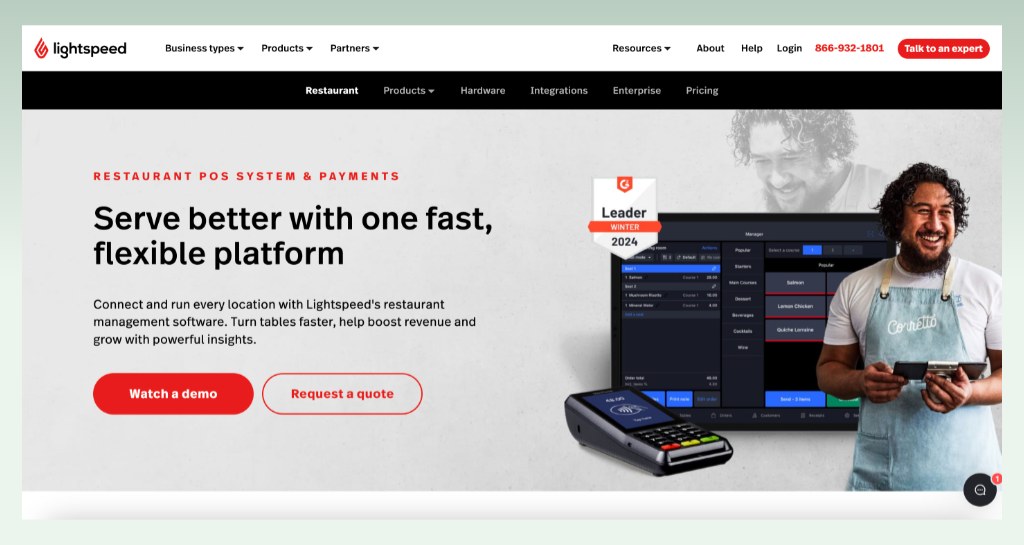
Lightspeed has carved a niche as a user-friendly and feature-rich solution for cafes and restaurants of all sizes. While Lightspeed caters to various food and beverage establishments, when comparing Shopify vs Lightspeed, it particularly shines for cafes seeking a fast and efficient checkout experience.
Some standout features of this best POS software for restaurants are:
- Order Management: Manage orders from various channels, including dine-in, takeout, and delivery.
- Menu Management: Easily create, modify, and manage menus with options for pricing, ingredients, and modifiers.
- Offline Mode: Maintain operation even during internet outages.
- Fast Checkout: Perfect for cafes with high customer turnover, facilitating contactless payments (Apple Pay, Google Pay) and quick order processing.
- Commission-Free Online Ordering: Expand reach and increase sales through online ordering without additional fees.
- SMS Marketing: Reach customers directly with targeted promotions and updates.
- Delivery Management: Seamlessly integrate with major third-party delivery channels like Doordash and Uber Eats.
However, it should be noted that Lightspeed doesn’t integrate with weighing scales, which makes it less suitable for self-service food businesses.
Lightspeed offers tiered pricing plans to suit businesses of various sizes:
| Starter | Essential | Premium | |
| Price | $69/month | $189/month | $399/month |
| Transaction fees | 2.6% + 0.10 for card-present transactions 2.6% + 0.30 for keyed-in transactions | ||
| Hardware packages | Offers kits for iPads, MacOS devices, and Windows PCs. | ||
3.6. SpotOn: Best for full-service restaurants with 1 or multiple units
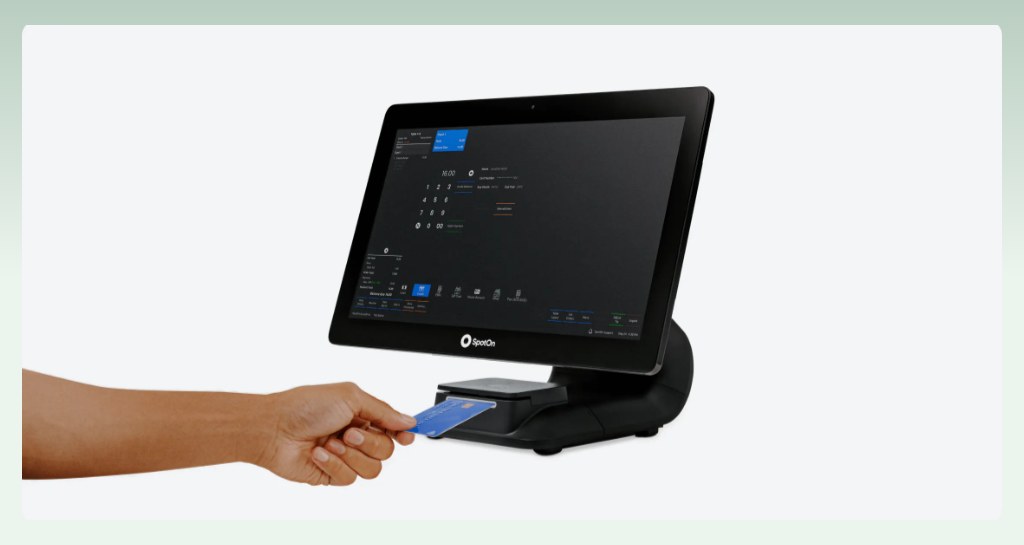
Launched in 2017, SpotOn boasts a loyal customer base with a focus on affordability, scalability, and exceptional customer support. As an ideal option for the best POS system restaurant owners could choose, it offers a compelling combination of user-friendly features, a generous free tier, and competitive pricing. Its robust staff management tools make it a valuable asset for busy restaurants with large teams.
However, the system doesn’t integrate with existing tablets, unlike some competitors. Additionally, some users have reported problems with SpotOn’s hardware, such as lagging terminals and faulty printers. It may also not be suitable for businesses needing advanced inventory or financial reporting.
Still, SpotOn is a strong contender with these key features:
- Staff Management & Scheduling: SpotOn shines with its comprehensive Teamwork integration, streamlining staff onboarding, scheduling, payroll, and other HR processes, a boon for busy managers with large teams.
- Inventory Management: SpotOn offers solid inventory management tools with features like stock tracking and low-stock alerts, helping businesses optimize inventory control.
- Customer Engagement: Features like QR code ordering and reservation capabilities enhance the customer experience and streamline ordering processes.
- Multi-Location Management: SpotOn facilitates centralized management for businesses with multiple locations, simplifying operations and ensuring consistency across outlets.
- Digital Kitchen Display System: Improves communication and order flow between front-of-house and back-of-house staff.
SpotOn offers a tiered pricing structure with a free plan and three paid options:
| Quick start | Counter-service | Full-service | Customize your own | |
| Price | Free | $99/month | $135/month | Custom pricing |
| Transaction fees | 2.89% + $0.25 processing minimums apply | 1.99% + $0.25 for most cards | 1.99% + $0.25 for most cards | 1.99% + $0.25 Custom rates may apply |
| Hardware packages | Offers several hardware options for businesses including include touchscreen monitors and payment terminals. | |||
💡Explore more practical tips and ideas designed to improve the efficiency of your restaurant business right here:
- Top 08 Best Restaurant Shopify Themes You Should Not Miss
- Best POS System For Takeaway Restaurants: Done & Dusted List
- The List of Best POS System For Pizza Shop
4. How to choose the best POS system for restaurants?
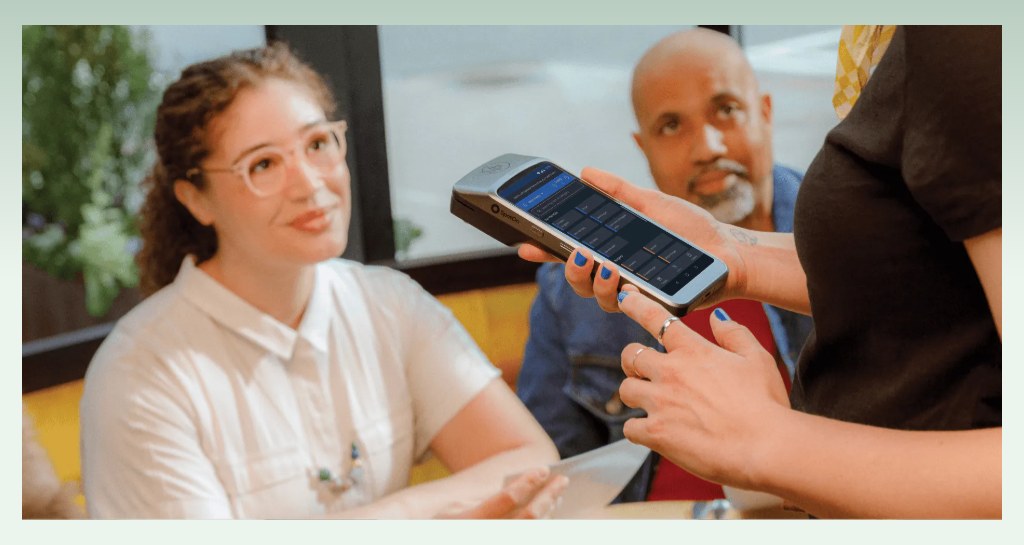
With a multitude of POS systems available, selecting the right one for your specific restaurant can feel overwhelming. Here are some crucial factors to consider:
- Restaurant Type: Different restaurant types have varying needs. For instance, a quick-service restaurant might prioritize a system with fast order processing, while a fine-dining establishment might focus on features like table management and menu customization. If you own a takeaway restaurant, be sure to check out our guide on the best POS system for akeaway to discover solutions that specifically meet your business needs.
- Budget: POS system pricing structures can vary significantly. Consider upfront costs, monthly fees, transaction fees, and any additional hardware or software expenses.
- Scalability: Choose a POS system that can adapt and grow alongside your restaurant. Ensure it can handle increased sales volume, additional locations, or menu changes.
- Ease of Use: A user-friendly interface is crucial for both servers and back-office staff. Invest in a system that offers comprehensive training and support resources.
- Integrations: Consider your existing software landscape and choose a POS system that integrates seamlessly with accounting software, payroll systems, online ordering platforms, or delivery services.
- Security: Data security is paramount. Verify that the POS system offers robust security features to safeguard customer information and financial transactions.
By carefully considering these factors, you’ll be well-equipped to choose the perfect partner, empowering your restaurant to thrive in the ever-evolving culinary landscape.
5. Summary
With the knowledge you’ve gained from this guide, you’re now well-equipped to navigate the world of POS systems and make an informed decision. Remember, the best POS system for a restaurant should be an extension of your restaurant’s unique vision, seamlessly integrating with your operations and propelling you toward success.
Now, go forth and conquer the world of restaurant management with eComStart!


